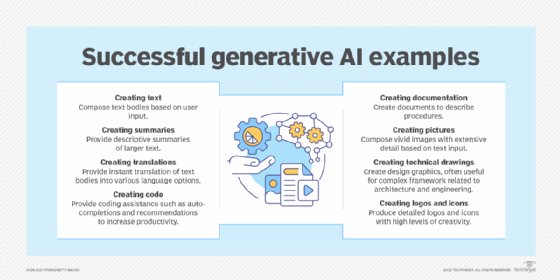
kras99 - stock.adobe.com
What is the role of generative AI in enterprise search?
Enterprise search employs AI to enrich content, identify objects and organize information. Yet, the rise of generative AI is likely to transform these processes even further.
Enterprise search consists of two components: the search experience itself and the content curation that precedes it.
Enterprise search is the technology category for finding unstructured information within an organization. For example, users look for answers to job-related questions within their company's vetted information sources. Organizations, in turn, secure and manage these sources within content repositories. The more precisely users define their queries, the better results they get.
When organizations began to add AI capabilities to their search strategies, these processes became more streamlined. Now, generative AI promises to further streamline the connections between the two and potentially get users better answers to their questions.
How enterprise search works
An enterprise search experience may include different facets for searching and suggest relevant categories to use. Depending on its design, the UI may list valid search criteria in a drop-down menu or recommend terms through text suggestions.
Initially, users must include the relevant search terms and ensure they search in the correct system or place. Somebody within the company must define the schema and introduce the controlled vocabulary or taxonomy to gather content from disparate repositories.
People must also tag content items with relevant terms, which complements metadata provided by the underlying OS, such as file names and dates last modified. Sometimes, this tagging occurs within the flow of everyday work. For example, office workers might fill out forms before filing documents that ask for relevant terms to include as tags.
Enterprise search after AI
These processes existed before AI and remain relatively unchanged in the current digital environment. However, newer content technologies, including AI, seek to improve search results by inferring connections among words and phrases in documents stored in content repositories.
For instance, AI could extract relevant words and phrases to automatically catalog documents. Semantic search, text sentiment analysis and similarity analysis can further present information based on predefined criteria.
Notably, these technologies use algorithms to extract meaning from text by feeding them predefined relationships among terms. Tools like natural language processing, machine learning and graph algorithms were once promoted as AI-powered tools but are now regarded as mainstream technologies to build enterprise search experiences.
How generative AI will change enterprise search
Generative AI (GenAI) is another promising technology to extract meaning from content. It uses neural networks, trained on enormous amounts of content, to produce large language models (LLMs) that mimic the cognitive connections of human brains. For instance, LLMs from OpenAI and Google access public information over the web, including copyrighted content from authoritative sources. Proprietary LLMs from other vendors, as well as open source initiatives, are also underway.

App developers use APIs to incorporate LLMs into applications. For instance, ChatGPT from OpenAI and Gemini from Google use each vendor's LLM. Microsoft licenses its LLM and associated APIs from OpenAI to produce a chatbot for Bing, now called Microsoft Copilot. Notably, the LLMs from OpenAI and Google incorporate general information collected from public, online sources, not a specific organization's content.
An enterprise search experience, however, is only as good as the sources on which it is based and the context in which questions are asked. The race is on to apply GenAI to enterprise search and offer better answers to users' questions. While general information used to train an existing LLM may be good enough in many situations, specialized content, attuned to the specific needs of an organization, is often better.
Thus, GenAI may transform enterprise search in the following ways:
- Users might supplement their enterprise search experience by asking an LLM questions. But, as they assess the LLM's results, they must be able to verify the content's accuracy and authority.
- Users might rely on a single search experience to query their content repository and an existing LLM simultaneously. While a unified search experience can save time and enhance productivity, users still must assess the LLM's accuracy.
- An organization might use its enterprise search investments -- content repositories, information architecture and knowledge graphs -- and integrate them with an existing LLM. This gives users a familiar UI to search within, however, the organization would need mechanisms to ensure the accuracy of LLM-generated results.
- An organization could train its own language model with domain-specific sources and store it within its content repositories. Often described as a small language model, this technique extracts meaning from content and uses vetted information sources. Users can quickly find the answers they need and trust the authority of the results.
Fulfilling GenAI's promises requires both technical and business savvy. Executives and senior technologists must assess the quality of their search environments and determine when investments in GenAI make sense.
Geoffrey Bock is principal of Bock & Company and advises organizations on content technologies and the future of business in the digital age.







